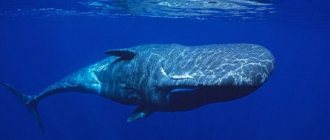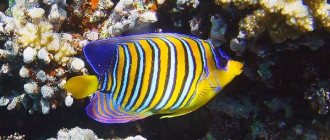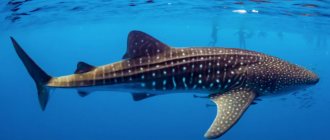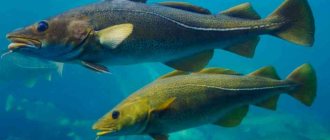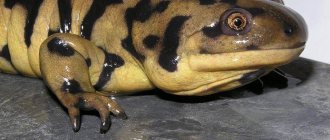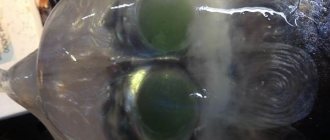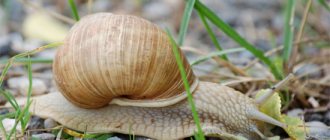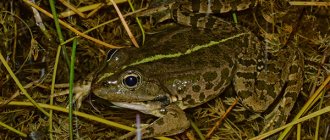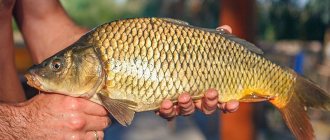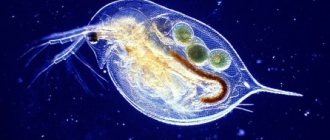The squid is a cephalopod, which is sometimes called the primate of the sea for the high level of evolution that it occupies among invertebrate marine animals. Due to the presence of a relatively well-developed brain, this animal is capable of cunning, deception and other intellectual manipulations for the sake of survival.
The mollusk very vaguely resembles a fish.
Fish or not
Orthodox Christians in Greece who prepared dishes from invertebrates during Lent said that they were neither fish nor meat. It’s not even a stretch to call squid fish. The marine animal is a mollusk, in which, in the process of evolution, the shell was transformed into an internal chitinous plate. The sizes of cephalopods range from a few centimeters (0.7 cm without tentacles) to eight meters. Most of the representatives of numerous families and suborders grow up to 50 cm.
Yandex pictures
The sides of the back of the squid's torpedo-shaped body are bordered by fins that act as a rudder. There are 10 tentacles on the head. Two arms are long, widened at the ends, the remaining 8 are short, cone-shaped. Tentacles with suction cups are needed to capture and hold prey during hunting.
The pair of eyes with lenses in some species differ in size.
Note! Observing the behavior of squids in their natural habitat, scientists came to the conclusion that their visual organs are capable of simultaneously looking at different objects. In this case, the eye of the larger diameter always looks up, and the smaller one always looks down.
The large eye detects pelagic fish, the small eye detects benthic organisms with a bioluminescent glow. In addition, all squids have a beak with powerful brown jaws (mandibles) and a radula with sharp teeth in the center of the corolla, which consists of the bases of the arms.
The animal's brain is formed by large ganglia that provide the functions of the sensory organs. Inside the head capsule, which is like a skull, the balance organs of the statocyst are located. They not only orient the mollusk in space, but also provide listening to low-frequency sounds.
Yandex pictures
The muscular or gelatinous bodies of animals are surrounded by a mantle, the streamlining and shape of which depends on the speed of movement. In the front part there is a funnel with a shutter device. Water enters and is released into the gap for reactive movement, in which the circular muscles of the walls participate.
Inside the mantle cavity there are paired gills, digestive, excretory, reproductive and circulatory systems. It is noteworthy that the squid's heart consists of three compartments. Two of them are designed to push blood through the gill vessels, the main one is to maintain blood flow throughout the body.
The oxygenated blood of cephalopods is dark blue, while the venous blood is pale. This is due to the fact that oxygen is carried through the bloodstream and supplied to organs and tissues not by hemoglobin, but by hemocyanin, a protein with copper atoms that colors the blood blue.
An ink sac with blue, brown or black pigment protrudes from the posterior wall of the rectum.
Important! The squid greets approaching enemies with an ink cloud, which temporarily paralyzes the olfactory organs and disorients them in space.
The ability of marine mollusks to bioluminescence is of interest to biologists. Some of them use the glow of bacteria, others emit light from photophores where luciferin oxidation occurs. Off the coast of Japan lives a 7-centimeter firefly squid, which belongs to the family Enoploteuthidae. Its body is covered with up to 1000 photophores. In daylight, it does not differ in color from other cephalopods; at night it luminesces blue.
Contraindications
Squid is a strong allergen. The benefits and harms of the mollusk depend on the habitat of the marine inhabitant. In recent years, the mercury content in water bodies has been rapidly increasing, and seafood absorbs and accumulates all industrial pollution. As a result, their nutritional value is suppressed. Such products pose a risk to human health.
Contraindications for eating squid:
- Individual intolerance to the product.
- Allergy.
- Stomach ulcer.
- Increased blood cholesterol levels. 100 grams of squid meat contains 260 milligrams of a harmful compound (87%).
It is not recommended to consume more than 150 grams of smoked or dried shellfish at a time, as they retain fluid in the body, provoke salt deposition, put a strong strain on the digestive tract, and worsen the condition of the skin. Boiled squid is free of these shortcomings; in terms of its composition, BJU is a dietary product.
What class does it belong to?
An invertebrate marine animal with five pairs of tentacles on its head belongs to the phylum Mollusca, class Cephalopods. In the process of evolution, the squid's "legs" were transformed into "arms" with suction cups.
Yandex pictures
Scientists include octopuses, nautiluses and cuttlefish in this class. Cephalopods have a number of features - a unique way of fast movement, active behavior, and the rudiments of intelligence. This group is higher than other invertebrates in terms of the level of development of the nervous system and brain.
Squid – Useful properties – Proteins, vitamins
Squids are nutritious and healthy. Cephalopods are truly a real storehouse of protein substances. The tissues of the squid's body contain many extractive substances that promote the secretion of digestive juices and give a unique taste to culinary products made from squid. In terms of chemical composition, raw squid tissues are characterized by a large amount of water and low fat content; However, some researchers prove that squid living in the waters of southern Sakhalin are richer in fat. Dry body tissues of the squid contain (in percent): proteins 81.4, fats 5.8, glycogen up to 1.4, minerals 10.2. Scientists claim that the squid’s body tissues contain B vitamins and microelements, and vitamin C has also been found.
Squid products
The muscular parts of the squid's head, body and tentacles can be used to make dried products. Dried squid is sold in the form of thin shavings resembling vermicelli. To prepare them, the dried squid carcass is cut into thin strips by machine, which are then packed in cardboard boxes, paper or cellophane bags. In addition to fresh-dried products, salted ones are also prepared from squid.
Method of cooking squid
Here is one of the methods for preparing salted squid products, recommended by I.V. Kiesewetter in the book “Catching and processing of commercial invertebrates of the Far Eastern seas.”
Fresh squid are cut - the mantle is opened, the entrails are removed, and the head is separated. Then the resulting raw material is washed in a saline solution (three to four percent salt). After thirty to forty minutes of exposure on nets to drain the washing water, the head (after removing the eyes and mouthparts) with limbs and body are rolled in salt and cut into small pieces, which are placed in barrels, where chopped squid liver is evenly added (twenty to twenty-five percent ).
For six to eight days, the contents of the barrels are stirred daily. Then they are sealed and kept for one to two months to mature the product. Before sale, the product is treated with rice yeast, and after two or three days of fermentation, the mass is poured into glass containers. In this form, squids go on sale.
Canned squid
Well-salted squid can be stored for quite a long time. Experience has confirmed that canned squid body tastes good - squid stuffed in its own juice.
How squid is prepared and consumed around the world
Usually it is boiled in salted water (for 1 kilogram of squid, take 2 liters of water and 15 g of salt), at a low boil for 3-5 minutes. The cooked squid is cooled along with the broth.
Sakhalin residents advise boiling squid for ten to fifteen minutes, despite the fact that they have just come from the sea.
Residents of the Far Eastern countries have invented dozens of ways to prepare squid for food. In Japan and China, cephalopods are eaten raw, dried, pickled, baked and fried. No body parts are wasted. They even eat eyes and suckers dried in a frying pan; they say they taste like nuts.
The fat is rendered from the insides of the squid, and the pomace is used to feed the chickens. On the island of Ischia (near Naples) squid is cut into slices and added to soup. In Spain, squid body rings baked in dough are popular. This dish can be bought in any store in Barcelona; all you have to do is heat it up at home.
Source: “Gifts of the Sea” M., “Economics”, 1968, Wikipedia
Squid lifestyle and habitat
Mollusks are widespread in the World Ocean from the Arctic to the Antarctic. Squids live en masse in the salty waters of the subtropics and temperate latitudes.
In fresh water and with a salinity of less than 30 ppm per liter. reproduction of invertebrates is impossible. For example, in the Black Sea with insufficiently salty water, squids and octopuses do not live.
In Russia, cephalopods are found in the northern and Far Eastern seas. Some prefer to hunt in the surface layers, others lead a bottom-dwelling lifestyle.
Yandex pictures
Squids that live in the north are smaller and have a pale, translucent color. Most invertebrate species gain weight in the coastal zone, at a depth of 100 meters. They are characterized by vertical migrations. Giant squids, which are not used as food by humans, descend below 600 m.
Pelagic mollusks with a slender, elongated body are constantly in motion and cover long distances. Migrations are distinguished between seasonal, feeding and spawning. Mollusks gather in large groups. Smaller individuals follow the larger ones, leading the pack.
This is interesting! Hiding from enemies, the squid sometimes jumps out of the water and flies through the air for tens of meters. If at this moment a ship passes nearby, the mollusk may end up on the deck.
Chemical composition
Squids do not have a distinct fishy taste; they vaguely resemble lobster meat. Properly cooked shellfish is soft and tender, it contains easily digestible protein, retains polyunsaturated fats and nutrients. Therefore, it is otherwise called “sea ginseng”.
Shellfish that have been thawed 2 to 5 times have the smell of old fish and a bitter taste.
To avoid poisoning the body, consuming such a product is prohibited. Table No. 1 “Nutritional value of squid meat”
| The nutritional value | Per 100 grams of product |
| Calorie content | 110 |
| Squirrels | 18 |
| Fats | 2,2 |
| Carbohydrates | 2 |
| Cholesterol | 0,085 |
| Ash | 1,4 |
| Water | 76,4 |
| Saturated fatty acids | 0,5 |
Table No. 2 “Chemical composition of squid meat”
| Nutrient name | Nutrient content per 100 grams of product, milligrams |
| Vitamins | |
| Niacin equivalent | 7,6 |
| Nicotinic acid (PP) | 2,5 |
| Tocopherol (E) | 2,2 |
| Ascorbic acid (C) | 1,5 |
| Thiamine (B1) | 0,18 |
| Riboflavin (B2) | 0,09 |
| Folic acid (B9) | 0,011 |
| Microelements | |
| Zinc | 1,8 |
| Copper | 1,5 |
| Iron | 1,1 |
| Iodine | 0,3 |
| Manganese | 0,17 |
| Cobalt | 0,095 |
| Molybdenum | 0,02 |
| Nickel | 0,011 |
| Macronutrients | |
| Potassium | 280 |
| Phosphorus | 250 |
| Sulfur | 180 |
| Sodium | 110 |
| Magnesium | 90 |
| Calcium | 40 |
Calorie content of shellfish per 100 grams is:
- fried – 175 kilocalories;
- boiled - 98.26 kilocalories;
- dried – 245.06 kilocalories;
- smoked - 286 kilocalories.
The most correct combination of squid with the following products:
- fresh fruits (apples, citrus fruits, pomegranate);
- fresh salad vegetables (bell peppers, cabbage, herbs, tomatoes).
The nutritional properties of the shellfish will be preserved as much as possible if you put it in salted boiling water and cook for up to 5 minutes.
Types of squid
Of the 250 species of cephalopods, 30 live in the territorial waters of Russia.
Common types of squid:
- Komandorsky. The invertebrate is a subject of fishing in the Bering, Okhotsk and Japanese seas. It has a flattened body and moves in a reactive manner, tail first. Mature individuals reach a length of 0.43 m. Features of the Commander squid are gray meat, eyes located on one side of the body.
Yandex pictures - Pacific. It is found in large numbers at depths of up to 200 m off the eastern coast of Japan down to Okinawa. Swims to the Commander Islands, found in the west of Sakhalin and near the Kuril Islands. Average dimensions - 25–50 cm, weight - 1 kg. The color of the meat is cream, white or light pink.
Yandex pictures - European. The range of the European or common squid extends from the North Sea to the coast of West Africa. The mollusk with light flesh grows up to 40 cm. It lives at depths of up to 500 m, but more often between 20 and 250 m. It is popular in Mediterranean countries.
Yandex pictures
Peruvian squid is hardly edible due to its ammonia flavor; Argentine squid is used for cooking exclusively fresh. Giant deep-sea mollusks have been little studied and are of interest to biologists. Their meat is soaked in ammonium chloride solution and is not used in cooking.
Where do giant squids live?
Giant squid can be found in oceans around the world at depths of at least 900 meters, but their exact geographic range is unknown. According to the International Union for Conservation of Nature (IUCN), giant squid are most commonly found in the North Atlantic and North Pacific Oceans, and near South Africa and New Zealand. ()
Some scientists believe that giant squid should be divided into several different species, including separate species for populations in the North Atlantic, North Pacific and Southern Ocean. However, a 2013 study published in the Proceedings of the Royal Society B analyzed 43 specimens of giant squid collected from across their range and found little genetic diversity. This suggests that the giant squid are one species and interbreed during migration. ()
Nutrition
It is difficult for scientists to determine what squid eat in the sea, since food that is crushed by the beak and radula with sharp numerous teeth enters the stomach.
Mollusk larvae grow quickly. Within a few hours after hatching, they feed on zooplankton from the eggs, the basis of which are copepods and euphausinds. Young mollusks eat the larvae of benthic organisms, bristlejaws, and crustaceans.
Adult squids eat a more varied diet. Predators, hunting from ambush, catch fish and similar smaller ones.
What exactly cephalopods feed on depends on the species and habitat. Pacific mollusks prefer mackerel, saury, juvenile half-snouts, luminous anchovies, and flying fish.
The northern short-toed squid from the Atlantic eats fry of gobies, cod, haddock, perch, capelin, and Mediterranean cephalopods - fish of the Myctophaceae family.
It’s not hard to guess what small squids eat. Their diet is dominated by fish larvae, caviar, and invertebrates. Mollusks eat not only animal food; they diversify their menu with algae, scraping plants from stones.
Invertebrates recognize prey by touch or using their visual organs. Animals throw out their arms within reach, hold fish or small squid with suction cups, then send food to the oral apparatus.
Note! Some species of squid inject toxic saliva into the bloodstream to paralyze prey; deep-sea invertebrates disorient benthic organisms with bright flashes of light from photophores.
What do giant squids eat?
Giant squid eat other, smaller species of squid and prey on fish, including the New Zealand grenadier (Macruronus novaezelandiae), a torpedo-shaped deep-sea fish. ()
Giant squids are themselves prey for sperm whales. But cephalopods don't die without a fight, and according to the American Museum of Natural History, sperm whales often have sucker-shaped scars after hunting giant squid. ()
Color illustration of a kraken attacking a ship, circa 1890. (Image credit: Photo Explorers/Getty Images)
The Kraken of Norse mythology, probably inspired by sightings of giant squids, is said to have appeared as small islands on the water to fool sailors into thinking it was land. As the story goes, the giant sea creature then used its tentacles to pull the ships and their crews under the waves. But humans are not part of the diet of true giant squids, and there is no reason for giant squids to attack ships.
Reproduction and lifespan of squid
Mating in squids occurs in two ways. In the first option, heterosexual mollusks press their heads together and intertwine their tentacles. The male transfers spermatophores extracted by hand from the cavity of the mantle to the female's spermatheca.
With another method of fertilization, the male swims up to the female from the side, clasps her body with tentacles and sends the seed sacs with a limb adapted for this purpose into the mantle cavity. Ripe spherical or pear-shaped eggs emerge from the genital opening there.
Bottom clutches of eggs are covered with a shapeless jelly-like mass or a protective capsule, which females attach to corals and stones with their hands. Cephalopods protect their offspring until death.
Yandex pictures
Eggs of pelagic clutches laid in the water column are immediately carried by currents over long distances.
Squids live from one to three years. The exception is the giant architeuthis, whose lifespan is 7–10 years or more.
Animal lifestyle
Squids are migratory mollusks; they travel great distances in search of food. The squid cannot be called either a solitary or a school animal, therefore there are both solitary individuals and large groups. If squids gather in a group and live together, then they hunt together.
The pygmy piglet squid (Helicocranchia pfefferi) gets its name from its barrel-shaped body and tiny “snout”, which is actually a photophore
Typically, the depth of habitat under water for the common squid ranges from 20 to 50 meters, however, for the most part, the depth of residence depends on the time of year: in the summer months the mollusk swims closer to the surface of the water, and in winter it goes deeper.
The squid often swims leisurely, making graceful strokes of its fins, but, if necessary, it can develop greater speed: to do this, it begins to rhythmically contract its muscles, thereby absorbing a large amount of water under the mantle, then, through a sharp release of water, it quickly pushes your body forward.
The body of the Hawaiian shorttail squid (Euprymba scolopes) is colored with symbiotic luminescent bacteria (Vibrio fischeri)
Enemies of the mollusk
Larvae and juveniles of squid are eaten by birds, predatory fish, jellyfish, and sea turtles. Mature cephalopods are hunted by:
- large species of fish - tuna, halibut, rays, pollock;
- whales;
- fur seals, seals;
- penguins;
- dolphins;
- sharks.
Yandex pictures
Squid are the main source of food for elephant seals, narwhals, bottlenose whales, beaked whales, and gray dolphins. Sperm whales consume 3 thousand mollusks per day. Albatrosses and petrels love to eat squid.
Human consumption
These sea animals are eaten fried, boiled, and baked.
To cook squid, there are a huge number of recipes. All of them can be selected only from the tastes of people and their wishes.
But, still, before making shellfish, you need to consider several basic points:
Frozen food must first be thawed before cooking.
It takes very little time to cook squid and it’s all easy to do.
They do not like rather long heat treatment, because after that they can become rubbery and tasteless.
Fresh products are cooked for about a couple of minutes until their meat becomes light in color.
Pre-cooked squid can also be cooked in batter. Here you will need to fry them in a frying pan for up to five minutes.
It is also possible to cook in the oven by marinating them in sauce or mayonnaise for a couple of hours. Cooking time until golden brown.
But, it should be remembered that cephalopods can retain their amazing qualities only with a short heat treatment time.
freepik
How squids are used by humans
In Russia, fishermen catch the only type of squid - Commander squid. Peruvian or Philippine shellfish reach retail shelves from abroad.
The tender, nutritious meat of invertebrates is used in cooking. Carcasses and tentacles are boiled, chopped and added to salads, fried in batter or without, in a frying pan and on the grill, canned, dried, stewed in gravy.
Squid is stuffed with various fillings and baked in the oven. The product is included in the recipe for risotto and pasta. Minced meat is used to make cutlets, filling for pies, cabbage rolls, and dumplings. The Japanese prepare sushi and rolls with shellfish. The eggs of invertebrates are also edible. The product is salted like “fish eggs” or boiled.
Yandex pictures
The antioxidant properties of cephalopod tissues and ink fluid are used in pharmacology. Dietary supplements are made from the nerve fibers of Commander squid; mollusk liver oil is a source of Omega-3 unsaturated fatty acids.
Important! The ink extract is active against Escherichia coli, gram-positive and gram-negative bacteria. Gelatin from the skin has an antihypertensive effect.
It is not for nothing that the squid, which has commercial value, is called the primate among invertebrates. Thanks to its developed nervous system, the mollusk is able to change RNA not in the nuclei of cells, but in the processes of nerve fibers, thereby reproducing proteins with specified functions. The study of cephalopods continues, as many secrets and mysteries remain.
Effect on the body
What are the benefits of squid:
- Reduce inflammation. The high selenium content (63% of the daily dose) in squid meat determines the antioxidant capacity of the product and reduces the manifestations of arthritis and pain.
- Helps absorb iron. 85 grams of shellfish contain 90% of the daily requirement of copper. This mineral is involved in the formation of red blood cells, the absorption and metabolism of iron, and prevents the development of anemia.
- Maintains healthy hair, nail plates, skin, and muscles. In addition, squid is the best source of animal protein, which is slowly digested in the human body and prevents you from gaining extra pounds.
- Stabilizes blood glucose levels.
- Reduce the risk of developing heart disease (stroke, heart attack) by reducing the level of homocysteine in the body.
- Relieves headaches and migraines due to the high content of thiamine and riboflavin.
- They supply bone tissue and teeth with “building materials” - phosphorus, calcium.
- Strengthens the immune system due to the presence of zinc in the composition. It has been scientifically proven that a lack of this element makes the body susceptible to infectious diseases.
- Reduces blood pressure and prevents the development of hypertension.
- Relaxes nerves and relieves muscle spasms.
- Remove heavy metal salts.
- Maintains a healthy endocrine and thyroid system.
Unlike meat from cattle and poultry, squid does not contain cholesterol, therefore it is allowed in the diet of people with heart and blood vessel diseases.
Other beneficial properties of shellfish:
- normalizes intestinal health;
- provokes the secretion of gastric juice;
- well absorbed;
- does not create discomfort or heaviness in the stomach.
Squids have a diuretic function, improve memory, stimulate mental activity, and promote rapid muscle growth. Therefore, they are an “ideal” dietary product for athletes and bodybuilders.
Squid brain. Mephisto - a squid with a human brain
Categories:
A creepy character in A. Yakubovsky’s story “Mephisto” (1972).
In the near future, people have finally learned how to transplant the human brain into another body. Moreover, recently, transplantation has become possible into the body not only of a person, but also of almost any living creature.
One day, one ocean scientist’s son fell ill (his name was Joe). The disease was fatal (sarcoma). Then the father decided to give his son a new life and at the same time open new horizons for his science. Thanks to new technologies, Joe's brain was transplanted into the body of a squid. The new creation was named Mephisto.
At first, Joe had difficulty getting used to underwater life. He had to master a new body, get used to unfamiliar sensations, discover new food, look for housing and learn to hide from predators. At the same time, Joe communicated with his father using Morse code and sent him information about the inhabitants of the depths. Joe had a very hard time and, sometimes falling into despair, he asked his father to take him in (so that he would put him in some kind of tank).
But when his father saw him in person, he was horrified and Joe, feeling his father’s feeling of disgust (of course, because the mollusk was looking at him), no longer sought to meet him.
...Mephisto crawled towards him, pulled his tentacles and looked with black eyes. They stared and, out of sudden excitement, rotated in opposite directions to each other. Large stitches of scar encircled the head. This sticky long body, which contained Joe’s soul and brain, was hated and gave birth only to fear...
Time has passed. Joe grew and gradually began to get used to the squid's body and its habitat. He still sent reports to people, but there was less and less humanity in his words. Joe wrote about new sensations, about how he catches prey, about his cave (about admiration for krakens). The human mind helped Joe become a very successful predator and soon he was able to kill and eat such a large creature as a dolphin.
Loneliness and the body of a mollusk changed Joe and he began to hate people and enjoy the fear of surrounding creatures (he reached enormous sizes). It got to the point where Joe capsized a boat with people and ate a man. Joe, feeling his strength, became aggressive and began to kill his competitors (giant squids).
Squids grow throughout their lives. And since Joe-Mephisto lived for a very long time thanks to his intelligence, he became so big that he began to hunt sperm whales. His hatred of people and his father, who did not accept him, intensified, and he began to sink entire ships. People called him the Great Squid...
How to figure out a monster, each cell of which is a separate organism?
Test from D. Campbell's story “Who's Coming?
Seth Brundle is the victim of an experiment gone wrong.
Teleportation and mutation in David Cronenberg's The Fly (1986).
How the maid took revenge on her mistress by turning her into a monster
Zuvembi from R. Howard's story "Pigeons of the Underworld" (1934).
Groot is a tree-like humanoid
Rocket Raccoon's assistant and friend from James Gunn's Guardians of the Galaxy (2014).
A dangerous experiment to discover other dimensions
The consequences of contact with another dimension from the horror film by S. Gordon “From Beyond” (1986).
Sacrifices to the gods using monsters
The idea of organizing a sacrifice from Drew Goddard's film "The Cabin in the Woods" (2011).
The plot of the scary story "The Cave" (1970) by Ronald Chetwynd-Hayes
A creepy story about a married couple and the death of the last Cornish giant.
How does the Alien reproduce?
Alien is an alien parasitic predator from a whole series of films: “Alien” (1979), “Aliens” (1986), etc.
Creepy illustrations for “Nyurguun bootur swift”
Drawings of monsters by E. Sivtsev, V. Karamzin and I. Koryakin.
Cuisines of the world
Today, squid dishes are popular in many countries. No matter how they are cooked: fried, stewed, pickled. For example, in Provence they are fried with garlic and butter or added to fish soups; in Greece they came up with a very interesting recipe: squid is stuffed with raisins, bread crumbs, rice, herbs and cream cheese. The Spaniards prefer deep-fried squid, and the Italians prefer it with stewed potatoes and tomatoes. In South America they prepare minced squid, and in Southeast Asia it is difficult to find a market where dried squid is sold.
How to cook?
Cooking Komandorsky squid is very simple if you know one secret, which we are happy to share with you! Komandorsky squid should be cooked for no more than 2-3 minutes, otherwise it will become “rubbery” and simply tasteless.
How to choose a good squid? What to look for?
When choosing squid, make sure that the color of the meat under the skin is a light, creamy color, and NOT milky white. Carcasses of this color were most likely chemically treated.
Features of use
If you have health problems, before eating squid, it is important to consult a doctor who will give recommendations taking into account existing diseases.
Pancreatitis
It is forbidden to eat squid for pancreatitis at the stage of exacerbation of the disease. This is explained by the product’s ability to activate pancreatic secretion.
During the remission stage, boiled, baked, and stewed shellfish meat is included in the menu. Add a small amount to salads or combine with vegetables.
Gout
Considering the presence of Omega-3, iodine and other beneficial compounds, squid for gout helps relieve inflammation and relieve pain, but only at the stage of remission.
You can't fry the carcass. It is advisable to bake, stew or boil shellfish meat. The broth should not be consumed. If the disease worsens, you must abandon this tasty product.
Diabetes
Squids are useful for diabetes. Of particular value is the inclusion of vitamin B3, which helps normalize sugar concentrations.
Explains the beneficial effects of easily digestible shellfish meat and the low glycemic index of squid, averaging 0-5 units.
To compensate for the deficiency of essential minerals and vitamins, it is enough to include seafood in your diet no more than twice a week.
Gastritis
In the absence of allergies, it is recommended to eat squid for gastritis, since the meat, rich in beneficial compounds, does not have a negative effect on the inflamed gastric walls.
It is important to exclude fried, dried, pickled products. Shellfish are useful for different levels of gastric acidity.
Application for weight loss
Squids are highly effective for weight loss, since light, nutritious meat with a high percentage of healthy protein satisfies hunger well.
Seafood intensifies the production of gastric juice, improving digestion. Weight loss is reflected in the ability of shellfish meat to remove cholesterol, relieve swelling, and activate metabolic processes. The dishes are prepared boiled or steamed.
Are shellfish allowed during Lent?
Squids are usually eaten during fasting on the same days as other seafood, including fish. These include the Annunciation and Palm Sunday.
Detailed recommendations for including shellfish in the diet during fasting can be obtained from clergy if desired.

